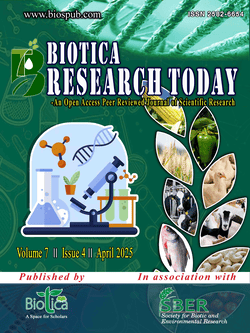
Bioethanol Production from Agro-Industrial Waste: Turning Agro-Residues into Valuable Biofuels
R. Kiruthika*
Dept. of Agricultural Engineering, Nehru Institute of Technology, Coimbatore, Tamil Nadu (641 105), India
R. Preethadevi
Dept. of Agricultural Engineering, Nehru Institute of Technology, Coimbatore, Tamil Nadu (641 105), India
DOI: NIL
Keywords: Bioethanol production, Distillation, Fermentation, Hydrolysis
Abstract
Bioethanol has emerged as a viable alternative energy source in response to the growing worldwide need for sustainable energy. Largely an underutilized resource, agro-industrial waste offers bioethanol as a sustainable and affordable supply. Residues, such as agricultural leftovers, food processing by-products and lignocellulosic materials, are a substantial amount of fermentable sugars, can facilitate bioethanol production. The pre-treatment of available substrates, followed by hydrolysis to break sugars into fermentable form, fermentation to convert carbohydrates to alcohol and distillation to purify the end product, will allow rapid and sustainable production of bioethanol. Using these wastes efficiently generates eco-friendly power and helps to solve major problems with waste management and its environmental effect. Improvements in technology turning agro-waste into bioethanol mark a turning point towards a circular economy and the realisation of world energy goals.
Downloads
not found
Reference
Cutzu, R., Bardi, L., 2017. Production of bioethanol from agricultural wastes using residual thermal energy of a cogeneration plant in the distillation phase. Fermentation 3(2), 24. DOI: https://doi.org/10.3390/fermentation3020024.
Guddaraddi, A., Singh, A., Amrutha, G., Saikanth, D.R.K., Kurmi, R., Singh, G., Chowdhury, M., Singh, B.V., 2023. Sustainable biofuel production from agricultural residues an eco-friendly approach: A review. International Journal of Environment and Climate Change 13(10), 2905-2914. DOI: https://doi.org/10.9734/ijecc/2023/v13i102956.
Mupondwa, E., Li, X., Tabil, L., Sokhansanj, S., Adapa, P., 2017. Status of Canada's lignocellulosic ethanol: Part II: Hydrolysis and fermentation technologies. Renewable and Sustainable Energy Reviews 79, 1535-1555. DOI: https://doi.org/10.1016/j.rser.2016.11.037.
Perdana, R., 2024. Bioethanol as a renewable energy solution: Opportunities and challenges in agricultural waste utilization. Asian Journal of Environmental Research 1(3), 201-216. DOI: https://doi.org/10.69930/ajer.v1i3.244.
Seidl, P.R., Goulart, A.K., 2016. Pretreatment processes for lignocellulosic biomass conversion to biofuels and bioproducts. Current Opinion in Green and Sustainable Chemistry 2, 48-53. DOI: https://doi.org/10.1016/j.cogsc.2016.09.003.
